The Mechanics of the Ephemeral
FLÁVIO CARDOSO, KILUANJI KIA HENDA, DAMARA INGLÊS, DÉLIO JASSE, RUI MAGALHÃES, SOFIA YALA
27.11.21 – 15.01.22 at Galeria Filomena Soares
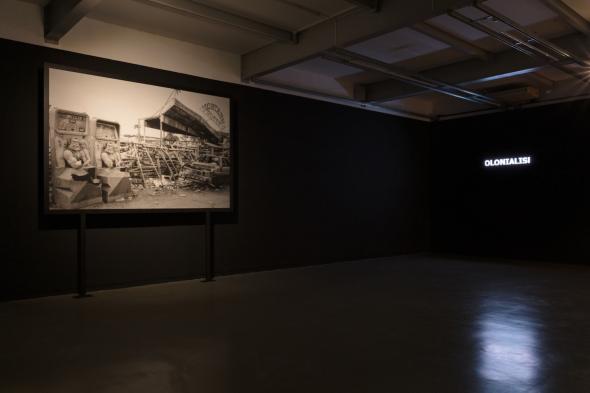 Kiluanji Kia Henda, Ópera da Distopia, 2013-2021
Kiluanji Kia Henda, Ópera da Distopia, 2013-2021
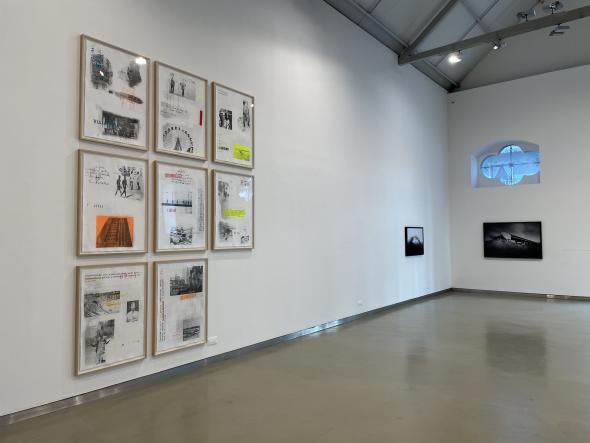
“The Mechanics of the Ephemeral” stems from the idea that art as a mechanism allows us to travel to different temporal spaces by adopting an approach that often resorts to fantasy, but in which the imagination becomes an important ally in historical and socio-political questioning. Although the discourses of the invited artists vary in their approaches and navigation of this temporal and identity- forming flow, the common denominator is their relationship with a continent inhabited by the dreams and follies of foreign ghosts. There is also an urgent need to address a future still based on meaningless promises of progress and freedom – a situation which is not exclusive to the African continent – to equally embrace the influences of the various artistic languages and references that comprise this joint work and overflow national borders and continental platforms.
“The Mechanics of the Ephemeral” is primarily an exercise in self-criticism of what the liberated peoples have done with their liberty. The exhibition also examines the final incomplete European fantasy of colonialism, a process that failed because it was interrupted, but which even today fosters an imaginary of imperialist, patriarchal and capitalist identity. This final fantasy perpetuates itself in the regimes that govern and have governed even after independence. The way the black elite exercises power is a mimicry of colonialism, which is based on classism. But colonialism is not the only plight that humankind suffers from. In its criticism, “The Mechanics of the Ephemeral” examines the interference of the Cold War superpowers in Angola, which, given their distant and icy approach, was always closely compared to a video game. As John Berger says in Ways of Seeing, “Publicity turns consumption into a substitute for democracy … Publicity helps to mask and compensate for all that is undemocratic within society. And it also masks what is happening in the rest of the world. According to publicity, to be sophisticated is to live beyond conflict.” No conflict was as sophisticated as the Cold War. War, in general, is seen as a highly publicised form of lethal entertainment, a game that slays lives and which we can always restart without however recognising that something has been lost along the way or how precious and irreplaceable it was.
On the same lines, few places on Earth are as privileged and publicised as theme parks. The ability to have the time and the means to enjoy, celebrate and consume without a care, regardless of the distance to be travelled, the cost of the ticket and the amount of free time available has made them the white man’s leisure space. The role of the black body, rather than participating, is to organise, clean and serve. The black body is a magical and invisible, almost mythical, entity that prepares the tables, the tracks, the views, the (resting) places and the rides. It is not invited to party or rest after the festivities, just to create the conditions so that others can. The alternative is to bar him from being present at all, even in the most precarious way. By refusing to participate (because the black man is also responsible for his body), by removing the body, we remove his pain, the violence he bears, protecting him, leaving those who encounter the desolation to carry the weight of the destruction caused, but now without a scapegoat.
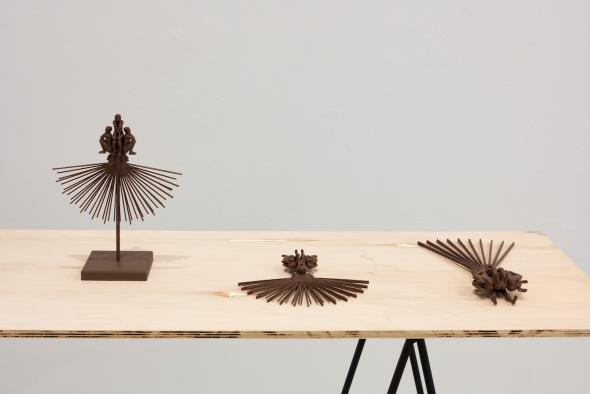 Damara Inglês, Pensariz / Samanhoga, 2021
Damara Inglês, Pensariz / Samanhoga, 2021
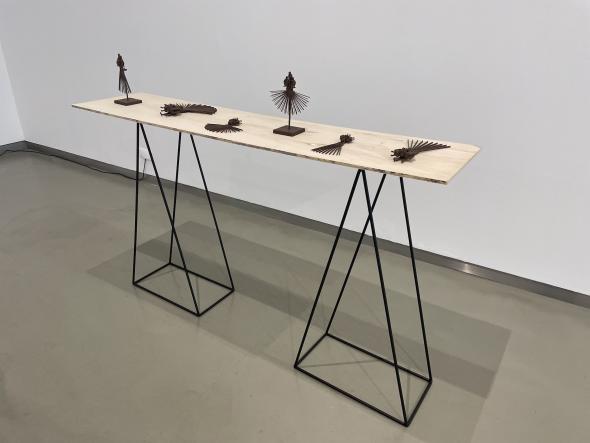 Damara Inglês, Pensariz / Samanhoga, 2021
Damara Inglês, Pensariz / Samanhoga, 2021
For a long time, the African continent was the colonialist’s playground, games room and bullring with a brightly lit sign reading “We’re on the outside”. Us, those who were already here. These places, now obsolete, are portrayed in “The Mechanics of the Ephemeral” in all their dysfunctionality. The separation is clear: the shells, structures, the bowels of society remain but the body is missing, as if it were interred somewhere under the rubble, with ferris wheels and rollercoasters as gravestones. Mountains that crumbled. As if the invisible can only leave their hiding places and observe what is left when the world ends. They are survivors but nevertheless deprived of those places in their fullness, condemned to the leftovers and the shadows, to have to continue to work to rebuild and, once more and forever, delaying the power of enjoyment. What’s missing? Who took it? And where has this small civilisation gone now the resources of this entirely artificial park have been exhausted?
According to Berger, “A people or a class which is cut off from its own past is far less free to choose and to act as a people or class than one that has been able to situate itself in history. This is why – and this is the only reason why – the entire art of the past has now become a political issue.” A concern about the future, a fear about the future and therefore, simultaneously, an almost intentional non-achievement of progress leave us with a safety margin, the same one on which advertising is still based today. The past will not return, but somehow it always seems more accessible and comfortable, almost like a mechanism for political well-being. We know how far from the past we are. We can still count the steps and retrace them to find what was lost somewhere: hence the prejudice, racism, etc. The future is more demanding and less patient. Berger also argues that the power of the art of the past should belong to anyone who can apply it to their own life. If seeing is an act of choice and looking an act of intelligence, the truth is that both are actions. To choose what others see is to activate what is hidden and therefore it resonates more painfully. Art, as the simulacrum of a possible future, pushes us towards an inevitable dystopia. But perhaps colonialism was already that dystopia and the powers established after independence a continuation of it.
The mechanics of the ephemeral force us to ask: is this what we should envy? Was this what they did with our natural resources, our work and life force? Was this the dream for which we should sacrifice our life and our children? Was this what they did to us? There is a corresponding concern in the work of the artists about the bankrupt power structures that govern us today. Nonetheless, there is hope in the works presented, which is probably only possible because there is much that is true in them. What we see is reality without the mask of dreams and illusions. The black gaze is shrewd, for in its imagination lies freedom, above all. The black gaze darkens and loves what it is, not what it was, nor what it could have been. He who looks, he who survives these time capsules may have to clean a very fine layer of ashes to arrive at a reconstructed and darkened portrait. This gaze knows that it will also survive whatever comes.
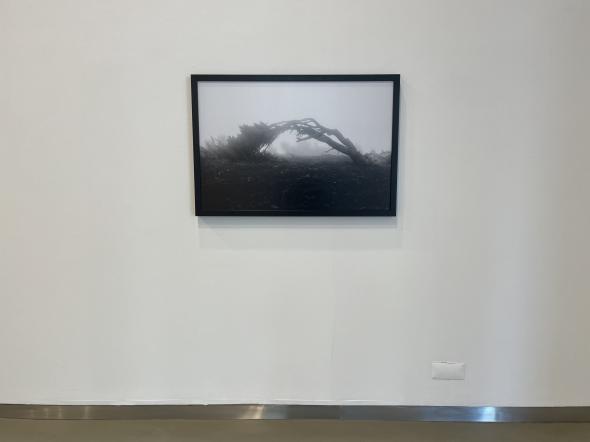 Alien no Limbo, 2020 (Flávio Cardoso)
Alien no Limbo, 2020 (Flávio Cardoso)
Flávio Cardoso illustrates what might be the portrait of the survivor in the short story The Comet by W. E. B. Du Bois. The chaos in these photographs does not represent the end nor does the end imply chaos for the last man alive on Earth: a black man, a messenger, who can now live as a full human being without the need for outside recognition. “He is alive, because the world is dead. In a ruined world, he had experienced a state of freedom that he had never enjoyed before. The rift between the old world and now offers new opportunities. The end of the world had freed him.” Thus does Saidiya Hartman interpret Du Bois’s story, which, like the world, also has a temporary end. Restoration is always possible, both of nature and humankind, even of that within it which is most inhumane. On someone else’s planet, we are always aliens. Having been an alien on your own planet is thus an extremely sophisticated technological and social skill, similar to the Apocalypse. Perhaps negritude was created for the way the world is now, even if not all of us can survive the third, fourth and fifth waves of the pandemic. The limbo between fallen nature and the unfinished bridge is an inhospitable place that represents this humanity. The desolation, the wait. In the end, perhaps life goes on for those who, as Audre Lorde says, were never destined to survive. Perhaps all that is left to us is to imitate trees, to wait for them, to share in their processes. Imagining the dystopia is to imagine the future, sustain the present and make peace with the past. “I’ve just had a baby,” says the artist. “We must have hope.”
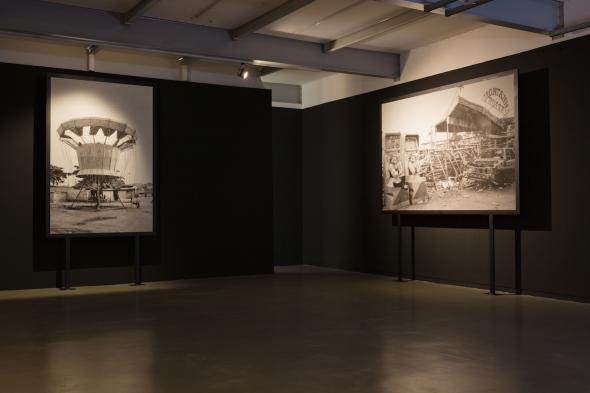 Kiluanji Kia Henda, Ópera da Distopia, 2013-2021
Kiluanji Kia Henda, Ópera da Distopia, 2013-2021
Kiluanji Kia Henda takes us on a journey which Achille Mbembe refers to as the “Anti- museum, not a museum without objects or an ephemeral place of objects without a museum but a kind of attic of the future whose function would be to embrace what was coming but doesn’t yet exist .” The renovation of this abandoned park was one of the signs that suggested a new future, a superfluous idea of progress, a major hope of change, the arrival of democracy and the end of twenty- seven years of war, above all in the minds of the adolescents of the time. However, it is one of those futures that never happened. Besides the derelict structure itself, what seeing this shutdown and completely obsolete park reveals is a machinery of dreams and emotions that today just reminds us of chaos and abandonment. Achille Mbembe recognises that “A vast imaginary undertaking of stripping, abandonment and demolition is now underway. The scale of the plot surpasses the African continent, which is nothing more than “A laboratory of planetary changes ” (Critique of Black Reason).
The abandoned park somehow represents the abyss into which Angola and many other countries around the world fell as the new world order arrived in the 1990s: the resurgence of the civil war (this time inside the cities), thousands of internal refugees, the introduction of rampant capitalism, the arrival of crack… Here lies the “Angolan paradox”, where the government’s main commercial ally was the USA and its political and ideological ally was the USSR. And there is nothing more American and more representative of imperialism than these theme parks, defiantly challenging those in a power struggle, as we see in one of the photographs exhibited. The eternal and lethal tug of war between Russia and the USA includes a series of phenomena that permanently destroyed any hope of better days.
“Increasingly, it’s probable that what is taken from us is priceless and can never be replaced. The absence of all possibility of restitution or restoration possibly marks the end of the museum, which ceases to be understood as an extension of the cabinet of curiosities to become the backdrop par excellence of humanity’s past, for which it will be the only point of reference.” Kiluanji Kia Henda also presents us with an electronic signboard with phrases taken from a historic mural at the Military Hospital in Luanda about the anti-colonial struggle, the resistance against colonialism and the need to keep the revolution alive. Like the theme park, this mural became another illusory device when welook at the discrepancy between the ideals fought for and what the country became. “The hour has arrived of the forge and the hammer, the embers and the anvil, and the blacksmith is probably the last avatar of the great historical figures.” As Mbembe recognised in Brutalisme, a lot of energy has been “expended, especially at the bottom of the social hierarchy, on interminable acts in the aim of fixing and repairing what has been bust, broken or just eaten by rust through a prolonged state of abandonment”. This installation consists of elements that are part of an aborted future, that make us reflect on how many more future landfills and scrapheaps we will find in history and how many dreams and desires perished thanks to the violence and madness of humankind which seems to have arrived late and been prevented from entering. It is still waiting in the queue for those better days.
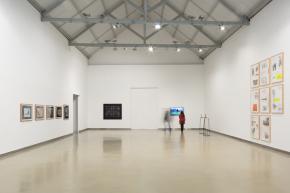 Sofia Yala, Type Here to Search, 2020; Rui Magalhães, Arqueologia do Futuro, 2020; Damara Inglês, Pensariz / Samanhoga, 2021; Délio Jasse, Untitled (da série A última barreira), 2021
Sofia Yala, Type Here to Search, 2020; Rui Magalhães, Arqueologia do Futuro, 2020; Damara Inglês, Pensariz / Samanhoga, 2021; Délio Jasse, Untitled (da série A última barreira), 2021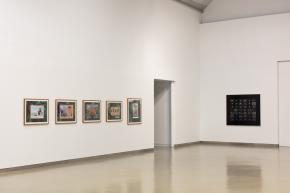 Sofia Yala, Type Here to Search, 2020; Rui Magalhães, Arqueologia do Futuro, 2020
Sofia Yala, Type Here to Search, 2020; Rui Magalhães, Arqueologia do Futuro, 2020
In Kazumbi, Damara Inglês presents us with an optimistic proposal for a transcendental humankind in symbiosis with nature, not hiding from its fury but accepting it as the last form of evolutionary survival. Along the same lines, the artist also presents Pensatriz, an intersectional figure that resembles one of the most powerful symbols of resistance – the Afro comb – denouncing the extractive mechanical process of the traditional aura of the objects. The aim is to give it a voice, as if the physical object were the shadow of the digital object, reversing the process of creation. The filter helps you to enter a connective, meditative and transformative state. The statue contrasts the youthful female body with the idea of the neutral, normative, universal, white thinker. As Jota Mombaça says in Não vão nos matar agora [They Won’t Kill Us Now]: “After being butchered, a body never returns to its intact state, so our body – inter-generationally butchered – is a testament to the fact that intactness is created through alliance. That our broken bodies find extension and organs in others and in things – in the flowers, in the earth. We have never been human, so we can be flowers and shit and sacred.” The sacred assumes many forms, including that of a protective digital filter, a skin that not only renews itself but also reveals itself to itself and to its digital soul. Through her female- decolonial gaze, Inglês criticises algorithmic racism, in which, irrespective of the filter, the basic avatar is always a white European woman. However, if the filter is a mask, whoever makes it is also a deity. All that is required is to place it on one’s own face and not just to worship it. According to Carl Einstein in Negro Sculpture: “With this metamorphosis, he [the Negro] establishes the balance with worship that can destroy him; he prays to god, dances ecstatically for the tribe and, thanks to the mask, transforms himself into the tribe and into god.”
Délio Jasse works with an Angolan archive covering the 1961–1970 period. The artist has made use of several phrases from the Declaração Histórica da Independência da Guiné, Angola e Moçambique [Historical Declaration of the Independence of Guinea, Angola and Mozambique] on overcoming “the last frontier: the legal framework of decolonisation”. This discourse, a pioneer of fake news and signed by the President of Portugal, António de Spínola, which still refers to “Portuguese Africa”, is as polemical as the colonialist propaganda that preceded it. The guerrillas are called upon to lay down their arms and to recognise Portugal’s recognition of their freedom and independence.There is a symbolic drawing of black hands shaking white hands in peace, partnership and friendship with a dove as witness. A new and free Angola forged by the Portuguese armed forces. Having no interest in the information it contains, in his work on decolonialism Délio Jasse invites Amílcar Cabral to the debate in his book Análise de alguns tipos de resistência [Analysis of Several Types of Resistance]. Dismantling and recreating the archive, the artist brings to the fore what was very often sidelined and remained conveniently unknown: notes, stamps and seals. “In front of the house attacked by terrorists,” says one photo from his huge archive. “ But who were the terrorists? The Angolans fighting for freedom?” The questions continue: “Who is in the photo and who is being written about?” The artist does not hide the facts; rather, he emphasises and underlines them like someone reading a book: “I always base things on an archive, never on my family. I begin writing a new past. We don’t know our own past, which is told by others, even though we are the ones who lived it. So I tell a new one from photos bought at the flea market, which is an informal archive different from legal or library archives. I’m not interested in showing the blacks or the glamour of the colonial lifestyle. I’m interested in denouncing old ideals, which is not optional.” The photocopies refer to the repetitiveness of the colonial discourse, a technique that also has to be used to dismantle this mechanism. You have to remember Cabral’s words: “We must create masses of propaganda about our resistance with all the means at our disposal. That is also culture.”
Rui Magalhães proposes an “Archaeology of the Future” forged through the geological and mechanical process of sedimentation by heat and chaotic traffic. This unusual numismatic reaffirms the current status quo: only some have access to what is exclusive, and their privileged place in history will continue to be ensured even after they have gone. Rather than the place one comes from, identity is what constitutes a person’s private property, be it watches, silver cutlery or objects by Chanel or Louis Vuitton. What is yours is worth keeping under lock and key, even if buried by them. Only the elite can travel to Mars, and only the elite will be able to return to the past or survive in the future. Lifeless but still standing giraffes guard the entrance to the fantasyland that is Luanda. How do you begin again in an “Eden” which was never really inhabitable without being in permanent reconstruction? What is the price to be paid to enter the garden? Who continues, who nominates the species and decides their place and function? Is this the garden where one civilisation began and another – or the same one – ended? And for anyone who dares to leave, what are the terms and conditions? Losing one’s head perhaps, the giraffes might say. Perhaps that is always the price, paid in a currency that is impossible to exchange and constantly devaluing.
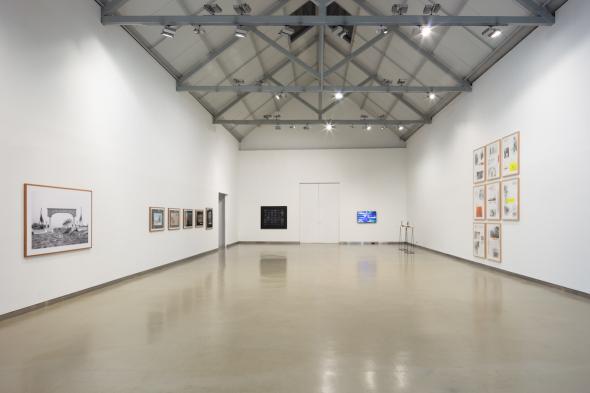 Rui Magalhães, Éden, 2020; Sofia Yala, Type Here to Search, 2020; Rui Magalhães, Arqueologia do Futuro, 2020; Damara Inglês, Pensariz / Samanhoga, 2021; Délio Jasse, Untitled (da série A última barreira), 2021
Rui Magalhães, Éden, 2020; Sofia Yala, Type Here to Search, 2020; Rui Magalhães, Arqueologia do Futuro, 2020; Damara Inglês, Pensariz / Samanhoga, 2021; Délio Jasse, Untitled (da série A última barreira), 2021
Sofia Yala Rodrigues sets down her grandfather’s suitcase on one of the most resilient and majestic of plants – the monstera. This process is transferred into the digital domain, where the weight of the real seems somewhat eased, where nature stimulates and embraces ancestral memory. In “Type here to search”, the artist is not searching for it: she knows where it comes from, having over fifty years of family archives in her hands, a rare occurrence in Angolan families. Rodrigues works from home and not the flea market, as most people do. By people, I particularly mean colonisers, collectors. The archive is not entire. Her mother and grandfather have worked on it, curating and subtitling it and leaving clues and signs. Her mother has ripped up photos of people she does not know. He grandfather has marked those who have already died with a cross. Flagging the invisible, the disappeared, is to honour their past. The artist, through collage and overlappings, combines these fragmented elements into her narrative, creating a link between the past and the present: strangers, family friends and family. Rodrigues does not try to recreate the gap but reinforces it. This is not a predatory archive but rather a place of nourishment. This is the exotified side of being the owner and organiser of her archive, her memory and her life. The search, the cleaning of this analogue drive, storing or reversing the changes, is conducted in her grandfather’s suitcase – a suitcase whose original owner may not have wanted it to be found, not just because it does not represent him, but also because it symbolises the movements forced by the colonial war. Perhaps it is more enjoyable and simpler to browse and romanticise another person’s family album. For anyone who has yet to find a way to connect the dots in their own, seeking it in Rodrigues’s continually updated archive is a good way to start.